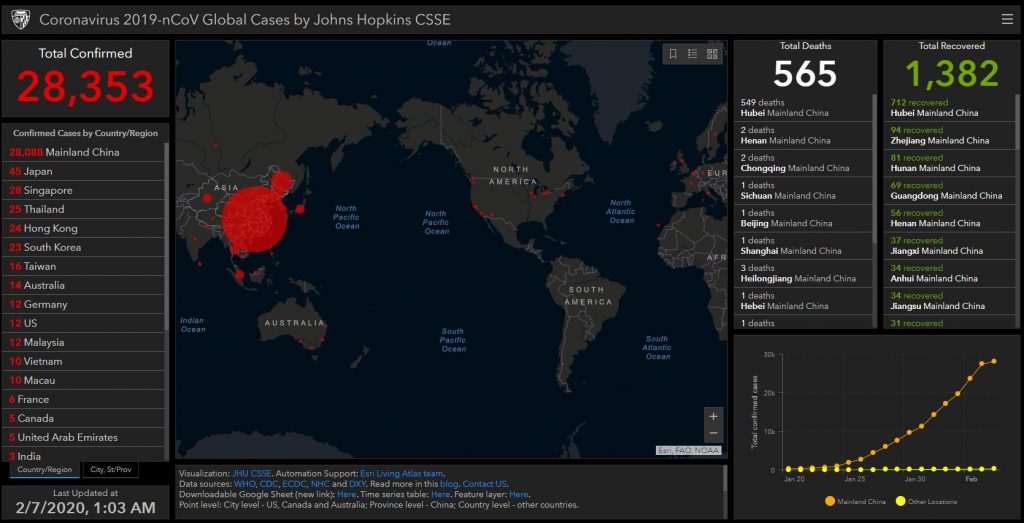
04 Feb ‘2019 Novel Coronavirus’ (2019-nCoV), Wuhan, China
This is an emerging, rapidly evolving situation. Here are some interim guidelines.
- Consider novel coronavirus (2019-nCoV) infection in patients with fever and respiratory symptoms who recently travelled to anywhere in China but in particular Wuhan, China.
- Investigate and manage patients for respiratory illness using standard practices.
- For severe respiratory illness, transfer patients to public hospital emergency departments for investigation.
- Contact your state/territory public health unit or communicable disease branch for advice on suspected cases including diagnostic testing and specimen collection. For contact details visit health.gov.au.
For live updates (like the image above) follow this link from Johns Hopkins CSSE:
https://gisanddata.maps.arcgis.com/apps/opsdashboard/index.html#/bda7594740fd40299423467b48e9ecf6
For more information – Department of Health (Australia) updates:
https://www.health.gov.au/resources/collections/novel-coronavirus-2019-ncov-resources
For WHO and CDC updates:
https://www.who.int/health-topics/coronavirus
www.cdc.gov/coronavirus/2019-nCoV/clinical-criteria.html
www.cdc.gov/coronavirus/2019-ncov/infection-control.html
https://emergency.cdc.gov/han/han00426.asp
Limited information is available to characterize the spectrum of clinical illness associated with 2019-nCoV. No vaccine or specific treatment for 2019-nCoV infection is available; care is supportive.
Health care providers should obtain a detailed travel history for patients being evaluated with fever and acute respiratory illness.
Criteria to Guide Evaluation of Patients Under Investigation (PUI) for 2019-nCoV
Healthcare providers should immediately notify Queensland Health in the event of a PUI for 2019-nCoV. Clinical and epidemiological risk are our current guides:
Fever and symptoms of lower respiratory illness (e.g., cough, difficulty breathing)
In the last 14 days before symptom onset, a history of travel from Wuhan City, China.
– or –
In the last 14 days before symptom onset, close contact
The criteria are intended to serve as guidance for evaluation. Patients should be evaluated and discussed with public health officials a case-by-case basis.
Recommendations for Reporting, Testing, and Specimen Collection
Healthcare providers should immediately notify liase with infection control personnel at their local hospital plus Queensland Health in the event of a PUI for 2019-nCoV.
Arrange transfer to the appropriate public hospital emergency department – please call ahead.
http://disease-control.health.qld.gov.au/condition/837/2019-ncov
https://www.health.gov.au/health-topics/novel-coronavirus-2019-ncov
Clinical Presentation
Fever may not be present in some patients, such as those who are very young, elderly, immunosuppressed, or taking certain fever-lowering medications. Clinical judgment should be used to guide testing of patients in such situations.
If following discussion, it is decided that the patient does not require hospitalisation:
- The local public health unit will provide advice on the exact specimens required for testing to identify 2019-nCoV
- As a general rule please collect all three specimen types i.e., lower respiratory (sputum); upper respiratory (nasopharyngeal and oropharyngeal swabs); and serum specimens
- Also screen for alternative causes includingother respiratory pathogens that may explain any patient presentation ie with multiplex PCR
- Request a chest x-ray if clinically warranted. Please ring ahead to notify radiology if this is a suspected case and ensure the patient is masked.
If following discussion it is decided a patient requires hospitalisation please arrange transfer to the appropriate public hospital emergency department – please call ahead.


